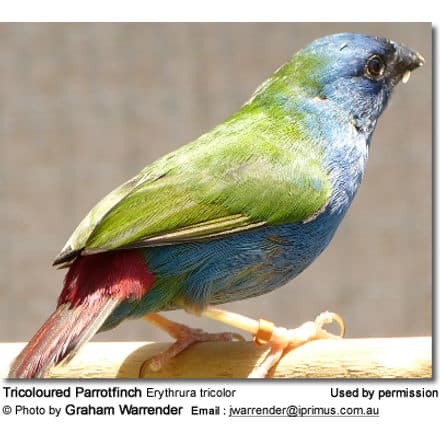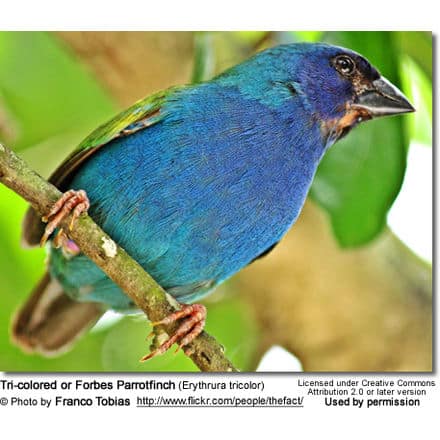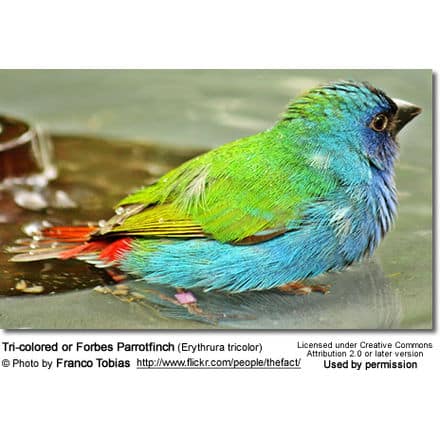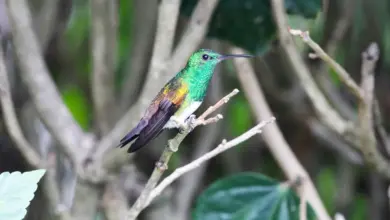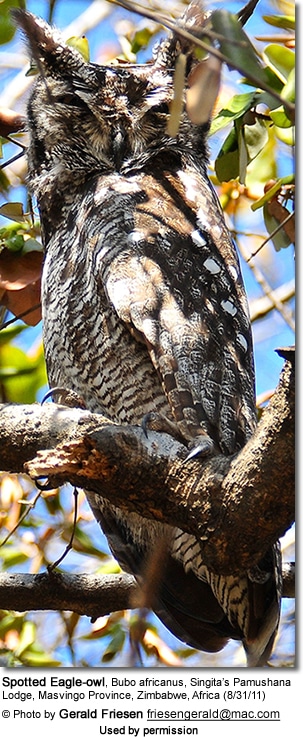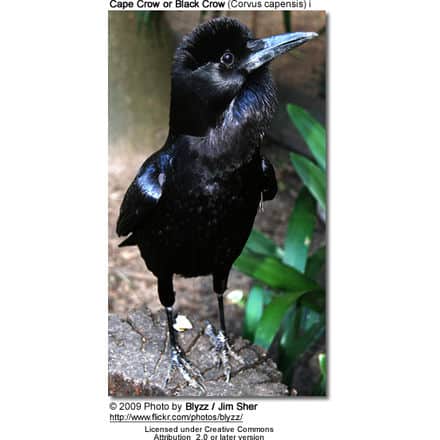Forbes Parrotfinches: Pairing birds, setting up housing, breeding
Tri-colored or Forbes Parrotfinches (Erythrura tricolor) are a rare find and are, therefore, not fully established in captivity. They are best suited for experienced breeders.
Overview … Alternate (Global) Names … Distribution / Habitat … Description … Breeding / Nesting in the Wild … Diet in the Wild
This species is a rare find and is, therefore, not fully established in captivity. They are best suited for experienced breeders.
Colony Breeding:
They are generally active, hardy, and easy to breed, and are compatible with many other finch species. Placing them with birds they are not compatible with may result in injuries or even death.
Another major problem to overcome is that many hybrids are being sold as purebreds. Caution is advised. To prevent hybridization, it is best not to house them with other Parrotfinches. Any resulting hybrids are typically sterile.
-
- Not suited :
- Parrot Finches (to avoid hybridization and aggression) – including other Tri-colored Parrotfinches
- Gouldian Finches (can get aggressive towards them)
- Not suited :
- Birds generally suitable for sharing an aviary with them:
They generally produce 3 clutches a year consisting of 2 to 3 eggs that are incubated for 12 to 13 days. Both parents share the incubation duties, which they do with tremendous dedication. The young fledge when they are about 21 to 23 days old and are fully independent 2 to 3 weeks later.
They tend to be good parents. Occasionally, breeders will use Society / Bengalese Finches as foster parents.
Personality / Behavior:
They have a very friendly and inquisitive personality and grow quite confiding with their caretakers, greeting them enthusiastically at the aviary door as they come in to tend to the flock.
These finches love water. One can frequently see them jump in and out of their bathing dishes. Bathing will take place a couple of times a day, summer or winter – and is an important part of their daily grooming.
Another characteristic of the forbes parrotfinches is their almost semi-nocturnal nature. They are always last to roost at night and can be seen still on the food station or darting around the aviary after dark. They are also the first to stir in the morning.
Aviary Requirements:
This breed is vivacious, very energetic, and always on the move. They are very gentle, which makes them an ideal choice for a mixed, large, and well-planted aviary with winter shelters (in colder climates). If kept indoors, an attractive flight cage with natural branches and maybe some plants would suffice.
They need plenty of flight space. A good aviary dimension would be 8ft. long x 7ft. wide. However, an aviary can never be too big for these active finches.
Some breed these parrot finches in canary-style cages indoors, but Tri-colored Parrot Finches tend towards obesity. An aviary will enable them to get the exercise they need to remain healthy. Plus Forbes Parrot Finches tend to be fairly nervous – so space for them to get away from perceived or real threats is important for not only their physical wellbeing but also their emotional. Birds that don’t feel some level of security are less likely to breed.
The setup within the aviary should encourage flying, as opposed to hopping from perch to perch. The nest box should always be placed at the highest point; the food/water containers on the ground (making sure that the space above them is free from perches to prevent the dishes from being soiled by birds perching above) and a couple of perches high up at one end and a couple of perches lower down at the other end – to encourage both vertical and horizontal flight. Keep perches and dishes away from any aviary door to reduce the risk of birds escaping as you open the aviary door (unless you have a security porch).
This tropical species needs to be protected from the elements. During the winter months, they need to have access to a heated shelter. The outside flight needs to have some draft protection. One way would be to install slotted tracking on the sides of the aviary that will allow you to slide in either Perspex or Polycarb sheets during the winter months to keep out chilly winds and help to keep heat in. Alternatively, such panels can be hung up along the sides – as long as they are firmly installed.
It is recommended to provide some cover within the aviary, which can be achieved by planting bushes suitable to your area or putting up appropriate brush, which even when dry seems to provide cover adequate for their needs. Tall grasses, small bamboo plants, and shrubs work particularly well.
Over time the breed has adapted well to cooler climates. However, when purchasing birds from a breeder find out whether the breeder uses artificial heating sources. It takes time for birds to acclimatize to your local temperature and conditions.
The pair bonding of the adult birds is very strong, and in the aviary, they are seldom seen apart. However, should either one die, a new partner should be introduced as soon as possible.
It is always advisable to have more hens in your colony than male birds, as it minimizes the potential conflict between males. Having said all that, give them food, water, and nesting material, and they are likely to thrive and breed. If within your aviary, you have the facility to grow a seeding grass, then you are guaranteeing yourself a happy flock of parrot finches.
Breeding:
Even though they may nest year-round, provided conditions are favorable for raising young – the best results are usually obtained from Spring to Autumn.
Forbes Parrot Finches can be paired up when they are as young as six months old; but for best results, they shouldn’t be encouraged to breed until they are one year old. Pair bonds are usually not strong, and they can be “repaired” as necessary. They shouldn’t be allowed to produce more than 3 clutches a year, as this could result in serious health problems for the females.
Captive parrotfinches readily accept a wide range of nesting accommodations, from standard “gouldian” or “budgerigar” nesting boxes, to open wooden nest boxes to wicker or cane elongated tubes. Nest boxes are usually reused for subsequent clutches, but they will usually refurbish it to their liking and add additional nest lining. For this purpose, adequate nesting material should always be available.
The nest box should be situated as high in the aviary as possible, although they are willing to settle for a nest box at lower levels. They tend to be excellent parents – however, it is characteristic of this breed that parents may set up a new nest, and be sitting on a new brood before the fledging of the last.
The hen seems to be the primary nest builder. Her preferred nesting material includes well-dried pampas grass, soft well-dried grass, or teased strands of hessian, cut to manageable lengths.
Fertility rates may be influenced by diet climatic conditions or the individual pair. Both parents share the incubation of the eggs, which lasts about twelve to thirteen days to hatching. Parrot Finches are generally tolerant to nest inspection, however, these should be kept at a minimum. For the 3 – 4 days preceding the hatching, the parents sit tightly in the nest until the young hatch.
Potential Problems:
Low temperatures:
Tri-colored Parrot Finches originate from a temperate climate, and they are “pre-programmed” to stop brooding as soon as 8 – 10 days after hatching. If the temperatures are too low, the chicks will die of exposure. In cases where the temperatures drop below 15 degrees C, it is important to provide supplemental heat.
Dry Summers / Low Humidity / Dehydration:
Low humidity can prevent chicks from hatching. About 3 – 4 days before hatching is expected, a dish with about 3 ml of water inside the nest box (away from the eggs) – may prevent that (note: a CLEAN, water-soaked sponge may work as well).
Should you find a chick or chicks with a skin color that is darker than you would normally expect, this may be indicative of dehydration. One cause could be a lack of green food or live food, such as mealworms or maggots – or a lack of bathing opportunities for the parents.
Chicks
The young usually fledge at 21 days. It is within this first week that the fledgling starts to take on the distinctive color of the breed.
Marker rings should be put on the fledglings when they are about 4 weeks old. Marker rings are an important tool for keeping track of them and for record-keeping purposes.
It is best to remove the young as soon as possible to allow the parents to potentially work on their second clutch or to avoid aggression towards the young.
If a second clutch is desired, the first clutch could also be removed and placed in the active nest of Society / Bengalese Finches for them to brood and raise as their own. Tri-colored Parrot Finches will usually replace a lost clutch with a new one; hence two clutches with possible young. Any young raised by foster parents should be removed from them as soon as they are independent and placed with their species to avoid hybridization.
Diet:
A good-quality seed mix should be provided, as well as soaked/sprouted seeds, seeding grasses, various greens, and live food – especially during the breeding season. They readily accept fresh fruits/veggies a lot, and greens such as parsley and dandelions. You can get a lot of free “green stuff” (safe, untreated plants please!) from your garden to feed them with.
While raising young, breeders often offer additional food items to the parents, such as hard-boiled eggs (potentially enriched with vitamins and minerals – if the diet is less than balanced), as well as sprouted seeds, and mealworms.
The fledglings readily accept live food, such as mealworms. They will take any size worm, and if too big to take at once, they will suck the pulp out of the worm. Green food, on the other hand, takes them about two weeks before they accept it. But once they have gotten used to live food, their appetite is fairly insatiable. Sprouted seeds are readily accepted by birds and are highly nutritious. They make excellent weaning food.
As with all other breeds, fresh water should be available at all times.
Finch Diet / Dietary recommendations to maintain optimal health in finches.
Specific Health Concerns:
Parasites
As these finches spend a lot of time foraging on the ground, breeders can expect to have to deal with a worm burden. Some breeders suggest that these finches do not respond well to worming, while others suggest the following protocol: “Mix 80 mils of water, 1.5 mils of Avitrol Plus, 2.0 mils of strawberry topping. The strawberry topping seems to make it more palatable without affecting the efficacy of the product. Use your judgment on whether or how often to administer. In most cases, 3 or 4 times a year seems appropriate, particularly if you are feeding live food. “
Whether or not such a routine is advisable for your birds should be discussed with your vet.
Obesity
The amount of soft food given should be monitored, particularly so when the aviary is too small to allow for a lot of exercise. Obese finches are less likely to reproduce or the eggs are infertile. A good-sized aviary, with lots of space for flying, will usually prevent that. A temporary diet of mainly white millet, red pannicum seeds, and plenty of greens and water is usually effective in reducing excess weight.
Species Research by Sibylle Johnson
Please Note: The articles or images on this page are the sole property of the authors or photographers. Please contact them directly with respect to any copyright or licensing questions. Thank you.

